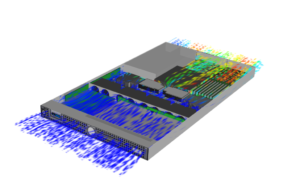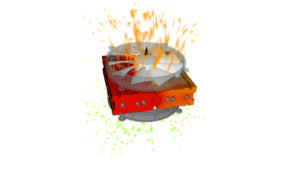Chris Aldham, product manager at 6SigmaET, investigates what thermal components are the best to buy for different device environments
 The electronics industry is driven by a constant demand for smaller and more powerful devices; this means increased power densities and a lot more heat being generated in ever-smaller spaces.
The electronics industry is driven by a constant demand for smaller and more powerful devices; this means increased power densities and a lot more heat being generated in ever-smaller spaces.
The result is that engineers are required to manage the risk of thermal design errors in every aspect of their product developments. Historically, the detailed thermal design of a product has often relied on ‘rules of thumb’ to ensure individual components function below their maximum operating temperatures.
As design complexity has increased, however, it is less and less viable to rely on ‘best guess’ thermal solutions. Instead, engineers must now develop highly complex thermal designs, and consider thermal issues from the very outset. This means carefully considering the specific components that they choose to include, and evaluating how these will interact within the finished product and its surrounding environment.
 Engineers are faced with squeezed budgets, shorter timescales and an ever-growing demand for energy-efficient devices; the days of simply adding more fans, or ‘over-engineering’ designs to ensure excess thermal margin, are long over. Now, engineers have to ensure that their designs have absolutely optimal thermal characteristics, and must choose their components accordingly – thermal performance is not an area where you can rely on general rules of thumb.
Engineers are faced with squeezed budgets, shorter timescales and an ever-growing demand for energy-efficient devices; the days of simply adding more fans, or ‘over-engineering’ designs to ensure excess thermal margin, are long over. Now, engineers have to ensure that their designs have absolutely optimal thermal characteristics, and must choose their components accordingly – thermal performance is not an area where you can rely on general rules of thumb.
So how do engineers select the right thermal components for their device environment?
Of course, component manufacturers generally provide official spec sheets and, in theory, the numbers can be used to guide buying decisions. Unfortunately, even the most detailed product specifications cannot account for the nuances of your specific design, nor for the various environments within which it may have to function. For those components that have an unusual geometry, or even for a particular combination of components, spec sheets merely provide a decent estimate – hardly enough to base a mass-purchasing decision on.
 It might be easy to decide to just buy the ‘highest’ spec components in the hope that this would guarantee adequate performance. However, this is an expensive solution and may not provide the best results. Giant aluminium heat sinks may initially appear to be a good solution to cool a power component, but if there is not enough airflow over the heat sink it will be almost completely ineffective. Likewise, the inclusion of a powerful fan will not be effective if the airflow generated by the fan completely bypasses the components you wish to cool. In this way, selecting the best components is rarely the same as selecting the right components for your specific device.
It might be easy to decide to just buy the ‘highest’ spec components in the hope that this would guarantee adequate performance. However, this is an expensive solution and may not provide the best results. Giant aluminium heat sinks may initially appear to be a good solution to cool a power component, but if there is not enough airflow over the heat sink it will be almost completely ineffective. Likewise, the inclusion of a powerful fan will not be effective if the airflow generated by the fan completely bypasses the components you wish to cool. In this way, selecting the best components is rarely the same as selecting the right components for your specific device.
Due to these complexities, some engineers traditionally relied on sampling components in order to perform physical thermal tests on prototype devices. This process relies on a great degree of trial and error, and is hardly cost effective. Often, determining the ‘right’ combination of components needed to balance a design’s thermal efficiency, energy consumption, cost and sizing takes dozens of variations.
 Thankfully, there is a better way. The introduction of easy thermal simulation software has drastically reduced the time and cost involved in sourcing the correct components for ideal thermal efficiency. By providing a unique visual representation of the temperature and airflow inside the equipment, simulation software allows engineers to build and test multiple product simulations for a fraction of the cost involved in producing a real-world prototype. By using thermal simulation suites such as 6SigmaET, designers can now model individual components and simply drag and drop those models onto their simulated devices. This provides an opportunity to view the potential hot spots of a design without purchasing components or building costly real-world prototypes. This approach provides a significant advantage for both designers and those involved in the wider electronics sourcing process.
Thankfully, there is a better way. The introduction of easy thermal simulation software has drastically reduced the time and cost involved in sourcing the correct components for ideal thermal efficiency. By providing a unique visual representation of the temperature and airflow inside the equipment, simulation software allows engineers to build and test multiple product simulations for a fraction of the cost involved in producing a real-world prototype. By using thermal simulation suites such as 6SigmaET, designers can now model individual components and simply drag and drop those models onto their simulated devices. This provides an opportunity to view the potential hot spots of a design without purchasing components or building costly real-world prototypes. This approach provides a significant advantage for both designers and those involved in the wider electronics sourcing process.
Essentially, thermal simulation is about encouraging better engineering decisions; decisions that make sense for designers, buyers, and ultimately, the end customer.
 CIE Components in Electronics
CIE Components in Electronics



